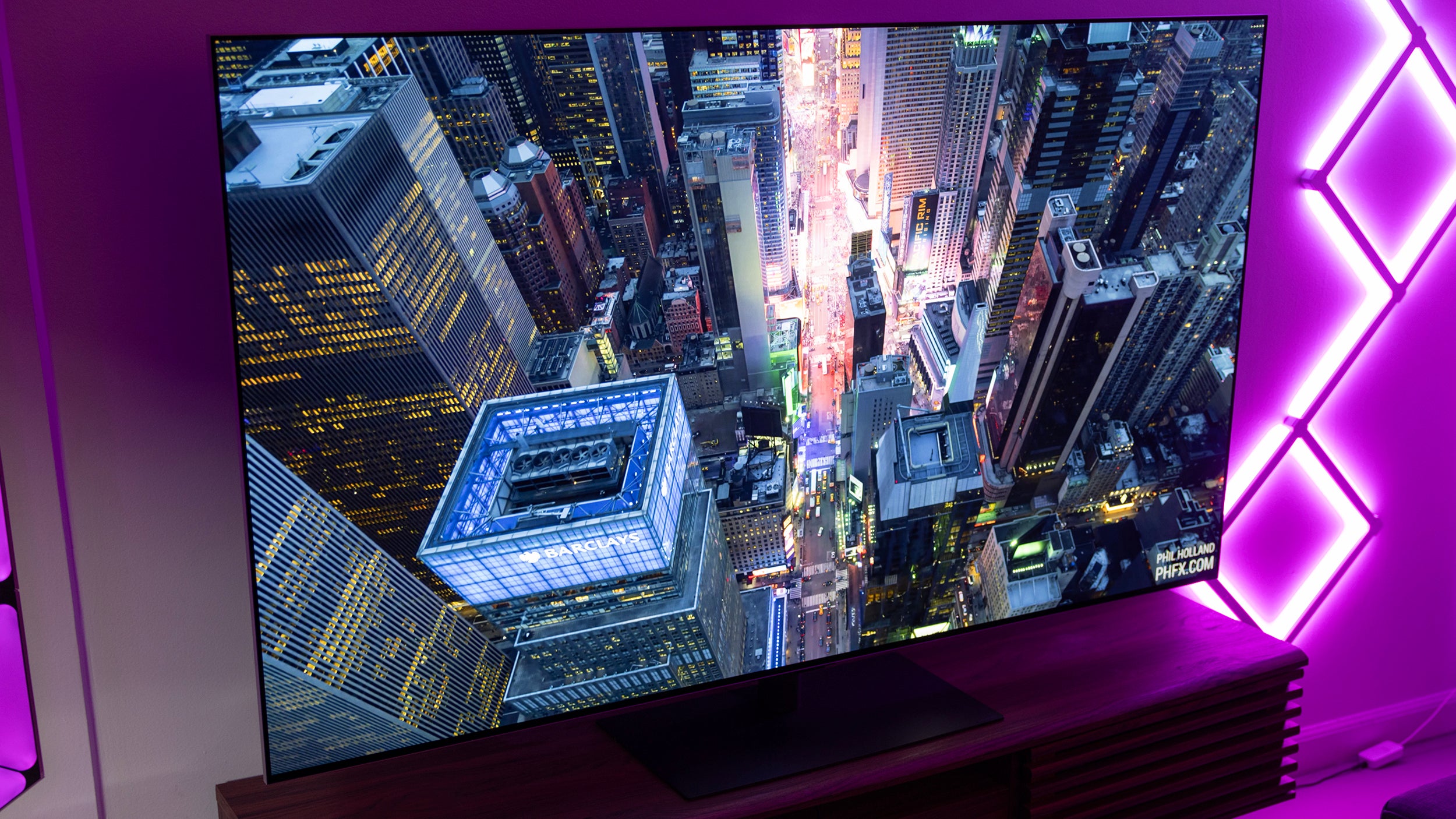For a short time, Samsung’s QD OLED panels were untouchable. Now, a few years after their debut, LG has refined its WOLED displays to the point where they are nearly as good as Samsung’s top-of-the-line OLED televisions while being slightly less expensive, offering more customization, and removing the baggage that comes with the Tizen operating system. It’s a real fight at the top and LG makes a damn good argument for itself.
LG G4 – Design and Build
LG’s OLED televisions have been downright beautiful for years and that doesn’t change with the G4. It has slim bezels and a thin overall chassis that when wall-mounted makes it no more obtrusive than a painting. If you’re not planning to wall mount, it comes with a stand that is the only weak point of the whole package.
Instead of the larger rectangular stand that shipped and sold separately with last year’s G3, LG went with an included stand on the 55- and 65-inch models that is much smaller and a lot worse. Once you’ve got it in place you probably won’t think about it again, but setting it up was a bit nerve-wracking.

OLEDs are heavy, so Samsung, LG, and Sony have typically chosen thicker, beefier stands for them. Not only does it keep the television more stable once it's in place but it is a helpful point of purchase to get the TV into position in a home. Because LG went with such a slim neck on the stand this time, it didn’t feel like a very secure hand-hold, which made setting up the G4 that much harder. Don’t try and set this display up alone: get help or you risk damage. If LG had just kept the stand from last year, I would have nothing to complain about on this television.
The 65-inch G4, which is the unit I evaluated with this review, is packed with ports. It has four HDMI 2.1 ports (capable of displaying 4K at up to 120Hz), one of which supports eARC. It also sports a LAN port, optical cable input, three USB-A ports, but no headphone jack. It does, however, support Bluetooth 5.1 and WiFi 6.

The cable management of the G4 is good, with the ability to route cables along the back and down through the aforementioned slim neck on the stand. That slim neck will get pretty crowded if you’re using all four HDMI 2.1 inputs with the thicker cables that go along with that standard, but they should fit. Once you’ve got everything all aligned, cables are not visible from the front.
The power cable is integrated into the G4, which I don’t like to see. Most won’t have an issue, but when a cable isn’t removable it’s also not easily replaceable. On the off chance that something goes wrong and that cable gets snagged or damaged in some way, you’ll have to get it repaired – not simply replaced.
LG G4 – Software and UI
LG is still using the venerable webOS to run its TVs and while it’s not the fastest car in the garage, it gets the job done and does so without overstaying its welcome. Yes, you can still control the cursor with the included remote in a Nintendo Wii-like manner. Waving it around brings up a cursor on screen to select items as if you were using a laser pointer.
You don’t have to use this system if you’re like me and prefer the more traditional button-based navigation. Just push any of the four points on the navigation pad and the floating cursor disappears. Some people love that Wii-like remote, but it’s not for me.

Interface-wise, webOS is pretty great. The home screen is not cluttered and doesn't force ads down your throat if you’ve disabled content recommendation (which I highly recommend). Once that’s gone, it’s a clean, simple interface that gives you access to all your favorite apps.
Speed wise, it’s fast enough but I can definitely discern a bit of lag between input and response. Navigating a menu can be particularly tedious as some settings are several layers deep. You won’t likely have to do this more than a few times after you set up your G4, so it’s not a big issue.
The settings are, gratefully, pretty detailed. You can adjust just about anything you want to fit your personal likes and dislikes. I prefer the brightness at max and Filmmaker Mode as my picture profile, for example. You can also adjust the color space very easily if you plan to use the G4 as a computer monitor. Basically, if you can think of adjusting it, it’s adjustable, but it’s not so overwhelming in LG’s menus that it will scare TV newcomers either. It offers way more control than Samsung’s Tizen and is about equal to Google TV.
LG G4 – The Remote
I mentioned the remote above and LG hasn’t done much to change it over the years. It’s still rather large and bulky, and features a notch on the underside that your pointer finger can rest in, making the Wii-like functionality all the more comfortable. For those who like navigating their TV like this, it’s great.

It still has a set of numbers at the top, a feature TVs have not really needed in almost 10 years now, and the wheel that is also the “select” button when depressed is a little too easy to accidentally scroll. It comes with a set of six pre-configured shortcut buttons oriented on the lower half of the remote. My review unit included Netflix, Amazon Prime, Disney+, and Sling as well as an “LG Channels” and Amazon Alexa shortcut, if you like using your TV as a smart home controller. I would have preferred a customizable button instead of either of those two, but that’s not a common choice among TV manufacturers.
LG easily held the title of largest and beefiest remote until Hisense bafflingly doubled the size of its remote this year, but I would still say LG’s is the thickest. I think the company should consider a smaller design in the coming years, but this is all nitpicking. It’s fine and gets the job done.
LG G4 – Picture Quality
LG provides what I feel is the best picture quality of any new OLED this year. It blends the best of OLED – perfect blacks, infinite contrast ratio, and outstanding color – with great brightness and a well-tuned set of picture profiles. With a Samsung television, your options are a lot slimmer and customization is far weaker. Eventually, you just have to be comfortable with having a certain look on a Samsung OLED. That’s not the case with the G4.
In short, images displayed on the LG G4 just look more true to life and require less work to get there than competitor OLED panels. Colors are bright and vivid without looking oversaturated and highlights are bright without becoming blinding.

One of the best parts of OLED is the wide viewing angle, and I can confirm that standing almost directly to the side of this panel results in no discernable image quality degradation. Even contrast is maintained and I didn’t notice any shifts in color hue either. If you have a large living room with seating in a wide arc, no one will be getting a worse viewing experience with the G4.
LG also supports Dolby Vision, which Samsung does not, as well as hybrid log gamma (HLG) and HDR 10, covering HDR bases well.
Speaking of HDR, the brightness of the G4’s 65-inch panel reaches around 1,400 nits in most cases, with a peak of 3,000 nits in some rare instances. Most of the G4 models use what LG calls Micro Lens Array (MLA) technology to get this increased brightness, but the largest 97-inch version does not. With that boosted brightness, HDR content looks outstanding as it can contrast with perfect blacks thanks to OLED technology where each pixel is individually controlled. Not only does that mean outstanding rendition of subjects on screen, it also means instantaneous pixel response, which is great for gaming, and no halo effect around bright objects set against a dark background. Captions, for example, are perfectly sharp on screen with absolutely no glow around the letters.
In testing, the LG G4 hit 100% of sRGB, 90% of Adobe RGB, and 95% of the DCI-P3 color gamuts with an average Delta E of 3.43, making it an outstanding performer, albeit a bit less so than last year’s G3. I’m not sure if this is a result of it being substantially brighter, although if so, it’s a trade I’m willing to make. The G4 tends to be a bit weak on the greens, but not by much.
Panel uniformity is a thing of beauty, with every corner of the G4 bringing rock solid color performance.
I think if the goal of buying an OLED is to use it as a monitor, last year’s G3 is probably a better fit given the slightly better color accuracy, especially in Adobe RGB. However for everything else, the better brightness is of higher importance and the slight dip in color accuracy is a fine tradeoff.
LG outfits the G4 with its α11 AI Processor, which is capable of boosting the performance of each pixel on the display to sharpen them as needed, adaptively manage colors, and reduce the appearance of artifacts in streamed content. The result is a spectacular viewing experience even when watching lower-bitrate streamed content or trying to view content from a service with less-than-ideal compression.
Basically anything viewed on the LG G4 looks spectacular. For those who already own an OLED – perhaps those using an older LG C1 or C2 – the brightness boost in the G4 is truly marvelous and does make a noticeable difference. What used to need a dark room for optimal viewing can now overcome glare to the degree that you can comfortably watch a mid-day baseball game with the blinds open. Sure, it’s even more dazzling at night, but LG has come a long way in the last few years to where the benefits of LED compared to OLED are shrinking fast, especially when the nicer LED televisions are almost as expensive.
LG G4 – Gaming Performance
When I say “anything” viewed on the G4 looks spectacular, that includes gaming. I tested the G4 with both a PC and a PS5 and in both cases, performance was immaculate. It has native support for G-Sync and FreeSync technologies, variable refresh rate, and up to 120Hz at 4K through HDMI 2.1.
Because pixels are controlled individually, lighting effects are as beautiful as they can possibly be and there is no delay when looking at bright areas and then transitioning to dark. The individual pixel control also means that they refresh instantly, giving the fastest feedback from input to view of any type of panel technology.
HDR gaming is just as impressive. After playing Destiny 2, Apex Legends, and Cyberpunk 2077 on the LG G4, it’s going to be very difficult to go back to anything else with the standard of color, contrast, lighting detail, and pixel response that it provides.

LG’s game menu is also fantastic, providing you with a mix of current output and options to tailor your viewing experience. The main menu shows mostly active settings and current frames per second, and navigating over to the Game Optimizer or All Settings buttons opens separate menus to fine-tune the experience.
For example, if you don’t want deep blacks because shadows are difficult to discern, you can bump them up with the Black Stabilizer.

This isn’t new information for anyone who has used an OLED television for gaming, but this technology is far and away the best for the hobby. The experience of going from LED to OLED absolutely fits the trope “from night to day” when it comes to the viewing experience. It doesn’t currently get better than this.
Last year I said it doesn’t get better for gaming than the G3, but every year LG pushes the envelope just a bit more and the improved brightness on the G4 makes that true yet again. If you want the best, you don’t have to look beyond what LG has here.
LG G4 – The Competition
LG’s G4 is best compared against the Samsung S95D, the Sony Bravia A95L, and the LG C4. Starting with the C4, LG’s Gallery series (hence the “G”) is meant to be its top-of-the-line, so the C-series TV isn’t as thin, doesn’t get as bright, and uses the Alpha 9 processor instead of the Alpha 11 processor found in the G4. That means it’s two generations behind LG’s latest sharpness, upscaling, and fine detail enhancer as well as its artifact and noise suppression tech.
The G4 is closer to Sony’s A95L, which did not get a 2024 refresh, and the same can be said for Samsung’s S95D. The choice among these three will come down to interface and customizability. If you prefer Google TV and care a lot about perfect color accuracy mixed with brightness, then Sony’s QDOLED is probably the better choice, although it is more expensive. Samsungs S95D is also more expensive, and while its color and brightness are fantastic, it tends to juice its saturation and contrast beyond normal, and it’s difficult, if not impossible, to draw them back down given Samsung’s neutered settings menu. Samsung’s Tizen operating system is also my least favorite, and the company has the weakest HDR format support of the group.







